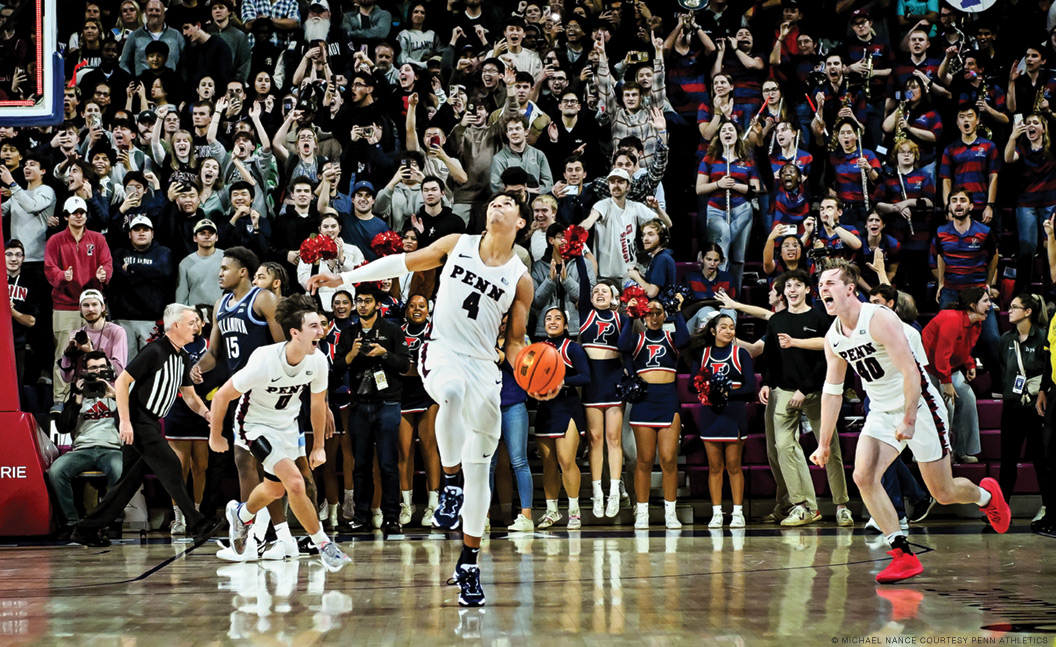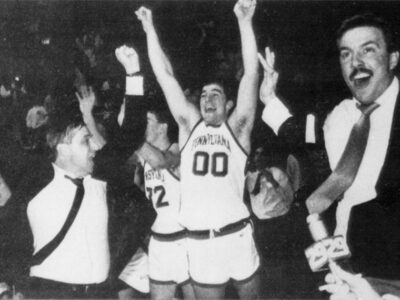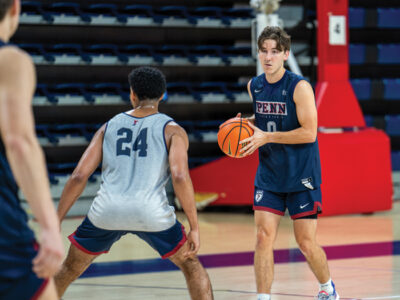
In a retooled men’s hoops city series, a stunning upset win over Villanova preceded an agonizing buzzer-beater loss to La Salle.
Five minutes after Tyler Perkins hurled the basketball toward the Palestra’s rafters to seal a 76–72 upset victory against Villanova—which is how long it took the freshman guard to extricate himself from the mob of students who stormed the court when the buzzer sounded—he confessed that he’d never heard of Philadelphia’s Big 5 hoops rivalry as a high school prospect coming up in Virginia.
What he did know is that Penn’s young and inexperienced men’s basketball team had more than a puncher’s chance against a ’Nova squad that rolled into the Palestra on November 13 with a top-25 ranking and a roster stacked with seniors and graduate transfers.
When asked in the postgame press conference when he thought the upset would materialize, Perkins replied “when we started to scout” the opposition, drawing laughter from the media and an incredulous look from head coach Steve Donahue.
“I felt confident with our guys,” said Perkins, who poured in 22 points to lead the Quakers. “And I feel like we matched up well with them. Coach had a great plan. So yeah, I knew.”
A balanced effort proved decisive as all five Penn starters scored in double figures, with Ed Holland III and Cam Thrower rising to the occasion to share the offensive load with Perkins and the team’s other focal points, leading scorer Clark Slajchert and big man Nick Spinoso.
But the keystone of Donahue’s plan was on the defensive end, where the Quakers lined up in a radically stretched 2-3 zone to guard the perimeter. Villanova struggled to get the ball into the high-post weak spot, as Penn’s top-of-the-key defenders worked hard to slip around ball screens and deny passes to ineffective flashers in the empty area behind them. And the Wildcats were ice cold from behind the arc, converting just nine of 33 attempts. Perhaps more surprisingly, given Penn’s stretched defensive formation, the Quakers outrebounded Villanova—with five Penn guards grabbing at least five boards apiece.
Penn only shot 21 of 34 from the free throw line but Slajchert delivered two clutch ones with 3.8 seconds left to ice the game after Villanova had cut the margin to two. After sinking the second foul shot, Penn’s senior leader allowed himself a slow smile as he nodded in the direction of no one in particular. Then, once a long ’Nova inbounds pass was batted away, Penn students poured onto the Palestra floor and threw red and blue streamers into the air. “It was amazing,” Slajchert said. “I’ve been thinking about that moment for a while.”
“That’s why you play college basketball. There’s not a better venue in the country,” Donahue said. “I always say the Palestra’s a front porch of our university. There’s a lot going on in this world, but this is a place we watch the Quakers and rejoice and come together. And I think these guys feel really good they provided the students with that.”
Because of a new Big 5 format, Penn’s upset of ’Nova was the only city series game played at the Palestra this season. The rest were held at other campus gyms and then the Wells Fargo Center—the South Philadelphia NBA arena that played host to a tripleheader on December 2. The move was designed to inject life into a once-proud city series tradition, with Drexel for the first time officially joining the mix and Philly fans getting treated to three games with one ticket.
The Quakers, by virtue of its win over ’Nova and loss to Saint Joseph’s in pod play, was slotted into the third-place game in the middle of the day. Villanova faced Drexel for fifth place before that and St. Joe’s squared up against Temple in the nighttime title tilt. (In past years the Big 5 champion was determined by the team with the best record in round-robin play, which often led to shared titles that were determined at various times in the calendar. The new format was designed to unsnarl the process with a true championship game.)
Although the historic Palestra—which had long been home to storied city rivalry games since the Big 5’s creation in 1955—was mostly cut out of the reimagined arrangement, Penn head coach Steve Donahue said he’s been a “big proponent” of the change. “I’ve been watching as a fan since sixth grade in 1973, and I loved it, but the world’s changed,” Donahue said. “College athletics have changed. I thought it was important we made this kind of move. I think it’s brought a really good spotlight on something that’s really special to our city.”
With the six teams all playing three Big 5 games (two in pod play that set up the Big 5 Classic tripleheader), there were fewer city contests this season than in past years. But the games delivered. Drexel scored an upset of its own over Villanova (which dropped all three of its Big 5 games this year, despite producing a couple of marquee early-season wins over non-Philly opponents). And St. Joe’s brought home the inaugural Big 5 Classic championship over Temple in front of two large and energetic sets of student sections that, in true Big 5 tradition, were armed with rollouts and streamers. (The total attendance at the Wells Fargo Center topped 15,000 but it was never close to that full at any one time, with students being bussed in to watch their respective schools and other fans filtering in and out throughout the day.)
The most dramatic ending, though, went to the Quakers, who took La Salle to overtime and then, with the game tied in the final seconds, celebrated a go-ahead layup from Slajchert. But La Salle’s Khalil Brantley responded by beating the buzzer with a heave from just inside halfcourt to shock the Penn faithful. When the ball banked in, the Explorers players danced on the court to celebrate their dramatic one-point win while Donahue slumped over the scorer’s table in dismay. “For fans, that was probably a fun 45 minutes,” the Penn coach said afterwards. “For coaches, at least for one of us, it was more agonizing.”
The coach on the other side from Donahue was Mr. Big 5 himself—Fran Dunphy, who led the Penn and Temple programs before his current stint with La Salle, recently having surpassed 600 total wins across all three gigs. Dunphy understatedly called it an “interesting week,” because three days before beating Penn—and his old protégé in Donahue—La Salle dropped a three-overtime thriller to his other former school, Temple.
“There’s no city that does this other than us,” Dunphy said. “And so we should really be praiseful of our culture in Philly.” Dunphy added that while “for all of us old timers, there’s nothing like the Palestra,” the Wells Fargo Center brings a different kind of fan experience. What it might lack in loudness, intimacy, and nostalgia, it made up for with all the perks of an NBA arena (including luxury suites, plenty of parking, and wider concourses).
The building got loud too, even if it was never full.
“It was crazy,” said Slajchert, who matched a career high with 33 points, with Perkins adding 20 and Spinoso 17 points and eight rebounds. “The craziest thing was looking up in the nosebleeds and seeing people. I’ve never seen that before.”
“I’ve been in other cities, and I think this is the best college basketball city in America,” Donahue added. “I thought the atmosphere was great.” —DZ
Senior editor Trey Popp contributed to this report.




